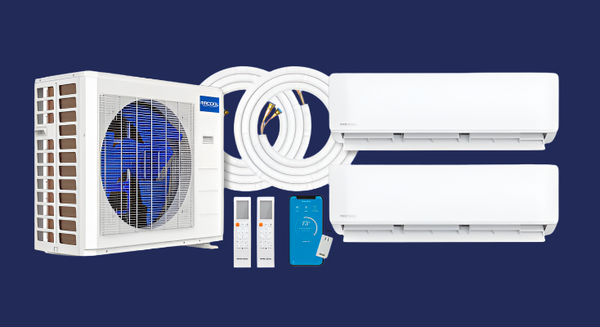How Mini-Split Systems Generate Heat: A Complete Guide to Heat Pump Technology
Mini-split heat pumps don’t “make” heat—they move it. That’s why a ductless mini-split can deliver quiet, efficient heating and cooling with lower energy use than resistance heaters or many furnaces. This guide explains the refrigerant cycle, cold-climate performance, and how to choose the right high-efficiency system for your home.
Shop all MRCOOL 5th Gen DIY mini-split systems Size your system (BTU calculator & hybrid builder)
Mini-Split Heat Pumps 101: Why They’re So Efficient
Unlike fuel-burning heaters, a mini-split heat pump transfers heat using a sealed refrigerant loop driven by an inverter compressor. Because it moves existing heat rather than generating it, a mini-split can achieve a coefficient of performance (COP) of ~3–4—producing 3–4 units of heat for every 1 unit of electricity.
- Lower operating cost: High SEER2/HSPF2 ratings reduce kWh use.
- Ductless design: No duct losses or dust recirculation.
- Zoned comfort: Heat rooms individually for better comfort and savings.
Long-tail targets: how mini split heat pumps work, ductless heat pump efficiency vs furnace, best mini split for cold climates, high SEER2 HSPF2 heat pump explained.
How a Mini-Split Generates Heat (Step-by-Step)
1) Refrigerant Cycle: The Core Components
- Compressor: Pressurizes refrigerant and raises its temperature.
- Outdoor coil (condenser in cool / evaporator in heat): Extracts heat from outdoor air—even below freezing.
- Expansion valve (EEV): Precisely meters refrigerant flow and pressure.
- Indoor coil (evaporator in cool / condenser in heat): Releases heat into your home.
2) Heat Extraction From Cold Air
The outdoor coil absorbs ambient heat (there’s thermal energy even below 32°F). Refrigerant boils into a gas, carrying that heat to the compressor.
3) Compression & Heat Amplification
Compression superheats the vapor. Higher pressure = higher temperature, allowing efficient heat transfer indoors.
4) Indoor Heat Delivery
The indoor fan blows room air across the hot coil; heat transfers to the air and circulates quietly and evenly.
5) Continuous Air Circulation (No Duct Losses)
Because mini-splits are ductless, there’s no leakage loss from long duct runs—just efficient, targeted heating where you need it.
Efficiency Comparison: Mini-Split vs Other Heating
| Heating Type | Typical Efficiency Metric | What It Means |
|---|---|---|
| Ductless mini-split heat pump | COP ~3–4, high HSPF2 | Moves 3–4× more heat than the electricity consumed; top seasonal efficiency. |
| Electric baseboard / space heater | COP ≈ 1.0 | All electricity becomes heat (no gain). Higher operating cost. |
| Gas furnace | AFUE ~80–96% | Some energy lost in exhaust/ducts; powerful in very cold climates. |
Do Mini-Splits Work in Freezing Temperatures?
Modern cold-climate mini-splits maintain strong output in sub-zero weather using advanced features:
- Low-temp inverter control: Optimizes compressor speed at low ambient temps.
- Cold-climate firmware + crankcase management: Protects oil return and startup.
- Defrost logic: Periodically clears frost for steady airflow and capacity.
- Optional auxiliary heat: Some homes add backup heat for extreme events.
Live in a very cold region? Consider dual fuel DIY HVAC systems (heat pump + gas furnace) for best-of-both performance.
Choosing the Right Mini-Split for Your Space
- Size correctly: Use the MRCOOL BTU calculator for finding the perfect system size.
- Single-zone vs multi-zone: Heat one room or shop MRCOOL 5th Gen multi-zone DIY systems for whole-home zoned comfort.
- Mount style: Wall mount for simplicity; ceiling cassette for flush, discreet installs.
- Feature set: Look for high SEER2/HSPF2, quiet dB(A), and smart app/voice control.
Ready to compare models? Shop all MRCOOL 5th Gen DIY mini-split systems for every home size.
Why MRCOOL DIY Direct?
- Quick Connect pre-charged lines: True DIY install—no vacuum pump needed.
- Hybrid options: Build a hybrid mini-split with a central ducted air handler for mixed spaces.
- Cold-climate and dual-fuel: dual fuel MRCOOL systems for severe winters.
- Packaged + central ducted: central ducted heat pumps (DIY-friendly) and packaged units for space-limited installs.
Mini-Split Heating FAQs
Is a mini-split cheaper to run than baseboard heat?
Can a mini-split heat an entire house?
Do mini-splits need auxiliary heat in cold climates?
Find Your High-Efficiency Mini-Split
Shop MRCOOL mini-splits Calculate your BTUs & build hybrid Explore dual-fuel options
Questions? Our experts can help you choose the best mini-split heat pump for your climate and budget.




